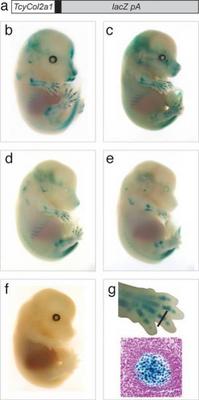Researchers from the University of Melbourne, Australia, and the University of Texas, USA, have extracted genes from the extinct Tasmanian tiger (thylacine), inserted it into a mouse and observed a biological function -- this is a world first for the use of the DNA of an extinct species to induce a functional response in another living organism.

|
| ©Pask AJ, Behringer RR, Renfree MB
|
| From extinction to gene expression. Functional analysis of the thylacine non-coding DNA fragment. (a) Diagram of transgene construct. 4 copies of a 264-bp fragment containing the Thylacine Col2a1 enhancer (TcyCol2a1) region was ligated to the human b-globin minimal promoter (black box) and ligated to lacZpA. (b--e) X-gal stained 14.5 dpc TcyCol2a1-lacZpA transgenic mouse embryo showing varying levels of reporter gene expression within the developing cartilage (blue). (f) Non-transgenic littermate, negative control fetus. (g) Top panel; Magnified image of forelimb from fetus in (b) black line indicates the plane of section shown in (g) bottom panel. Bottom panel; Histological section of transgenic forelimb digit, showing lacZ-expressing chondrogenic tissue (blue) counterstained with eosin (pink).
|
The results showed that the thylacine Col2a1 gene has a similar function in developing cartilage and bone development as the Col2a1 gene does in the mouse.
"This is the first time that DNA from an extinct species has been used to induce a functional response in another living organism," said Dr Andrew Pask, RD Wright Fellow at the University of Melbourne's Department of Zoology who led the research.
"As more and more species of animals become extinct, we are continuing to lose critical knowledge of gene function and their potential."
"Up until now we have only been able to examine gene sequences from extinct animals. This research was developed to go one step further to examine extinct gene function in a whole organism," he said.
"This research has enormous potential for many applications including the development of new biomedicines and gaining a better understanding of the biology of extinct animals," said Professor Richard Behringer, Deputy Head of the Department of Molecular Genetics, M.D. Anderson Cancer Center, at the University of Texas, who is the corresponding author on the paper.
The last known Tasmanian tiger died in captivity in the Hobart Zoo in 1936. This enigmatic marsupial carnivore was hunted to extinction in the wild in the early 1900s.
Researchers say fortunately some thylacine pouch young and adult tissues were preserved in alcohol in several museum collections around the world.
The research team used thylacine specimens from Museum Victoria in Melbourne Australia to examine how the thylacine genome functioned.
The research team isolated DNA from 100 year old ethanol fixed specimens. After authenticating this DNA as truly thylacine, it was inserted into mouse embryos and its function examined.
The thylacine DNA was resurrected, showing a function in the developing mouse cartilage, which will later form the bone.
"At a time when extinction rates are increasing at an alarming rate, especially of mammals, this research discovery is critical," says Professor Marilyn Renfree, Federation Fellow and Laureate Professor in the University of Melbourne's Department of Zoology, the senior author on the paper.
"For those species that have already become extinct, our method shows that access to their genetic biodiversity may not be completely lost."
Journal reference:
Resurrection of DNA Function In Vivo from an Extinct Genome -
LINK.
Adapted from materials provided by
Public Library of Science, via
EurekAlert!, a service of
AAAS.
Reader Comments
to our Newsletter